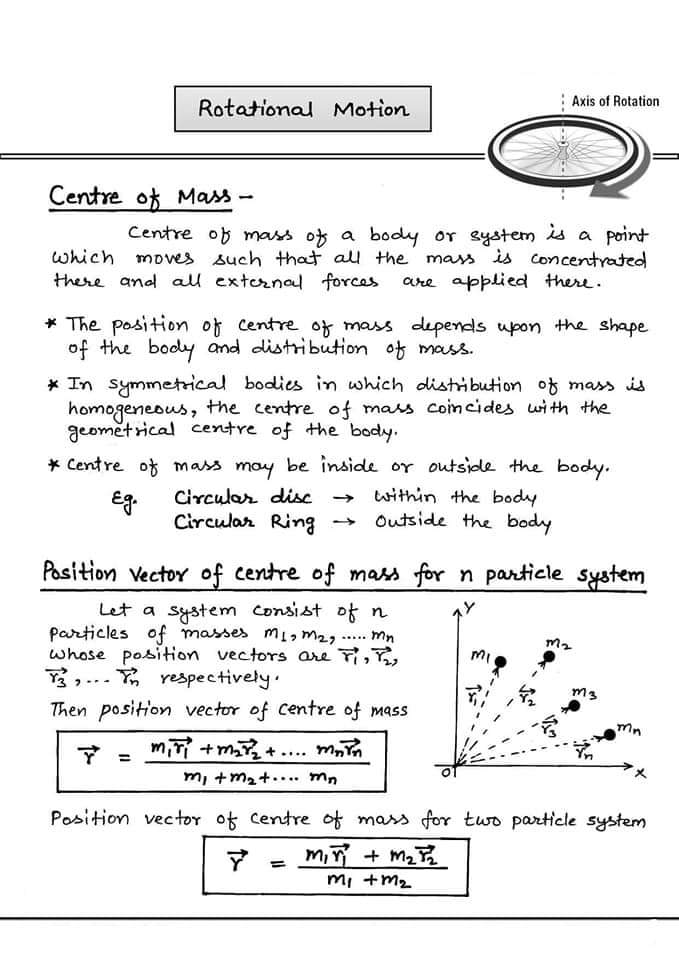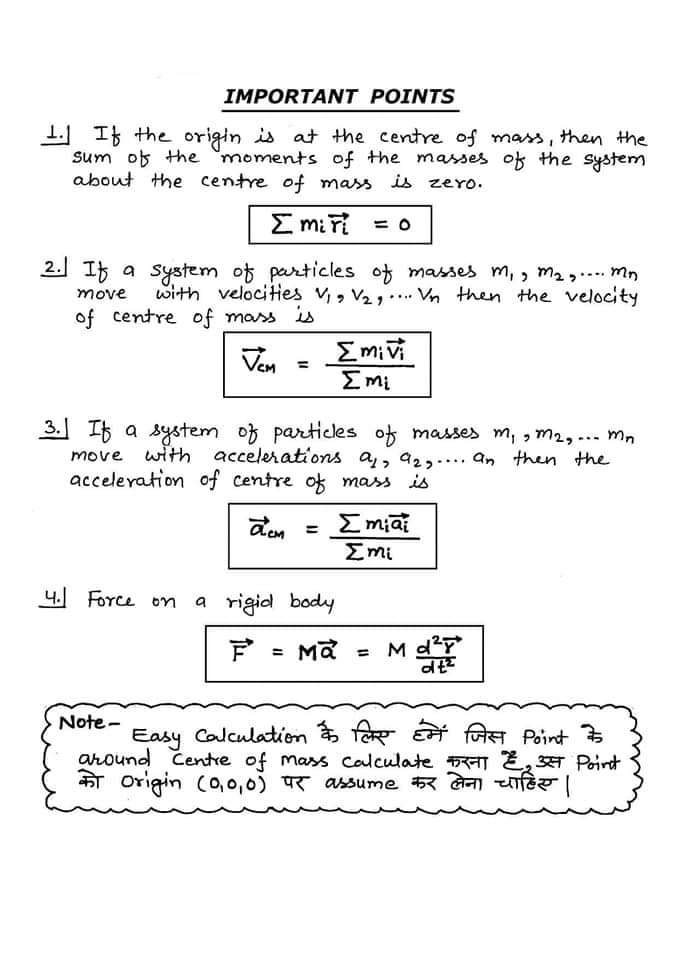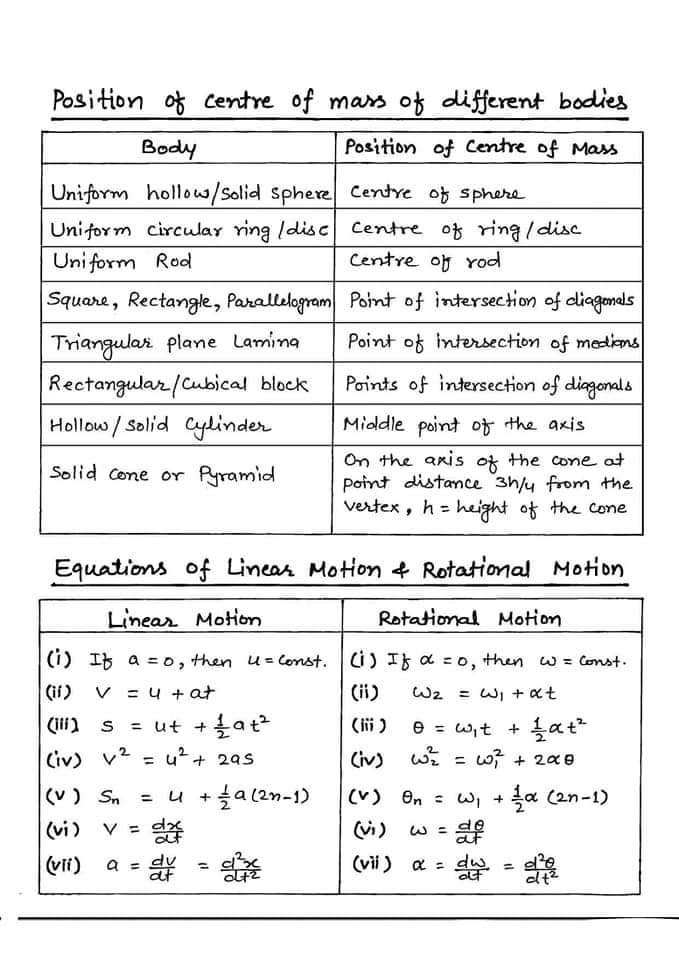


Objective Questions Based on Center of Mass
- A particle performing uniform circular motion has angular momentum L. If its angular frequency is doubled and its kinetic energy halved, then the new angular momentum is
(a) L/2
(b) L/4
(c) 2 L
(d) 4 L - What is the rate of change of angular momentum?
(a) Force
(b) Torque
(c) Work
(d) Angular velocity - A particle of mass 5kg is rotating about an axis in a circle with a speed of 10m/s. What should be its radius so that the component of angular momentum about the axis is 5kgm2/s?
(a) 0.1cm
(b) 10cm
(c) 5cm
(d) 0.5m - The distance between the centers of carbon and oxygen in the carbon monoxide molecules is 1.13 x 10-10 m. The distance of the centre of mass of the molecule relative to the oxygen atom is _____
(a) 0.48 x 10-10 m
(b) 0.64 x 10-10 m
(c) 0.56 x 10-10 m
(d) 0.36 x 10-10 m - Two particles of masses 2 kg and 3 kg are at rest and are separated by 10 m. If they move towards each other under the mutual force of attraction, they would meet at _____
(a) 6 m from 4 kg body
(b) 6 m from 6 kg body
(c) 4 m from 4 kg body
(d) 5 m from 6 kg body - A ball of mass 3 kg and a ball of mass 2 kg roll towards each other on a flat surface. How far is the centre of mass from the 3 kg ball of the 2 balls are separated by 6 m?
(a) 1.2 m
(b) 2.4 m
(c) 3.6 m
(d) 4.8 m - Three identical spheres each of radius R are placed such that their centres lie on a straight line. What is the location of their centre of mass from the centre of the first sphere?
(a) R
(b) 2R
(c) 3R
(d) 4R - The centre of mass for an object always lies inside the object.
(a) True
(b) False - For which of the following does the centre of mass lie outside the body?
(a) Pen
(b) Dice
(c) Rectangular tile
(d) Bangle - An asteroid enters the atmosphere of the earth and breaks into two pieces. One of the pieces is larger than the other. Which of the following is true considering the centre of mass of both the pieces together?
(a) The centre of mass shifts horizontally towards the larger piece
(b) The centre of mass shifts horizontally towards the smaller piece
(c) The centre of mass remains in the same trajectory as before breaking apart of the asteroid
(d) Depends on the velocity of the asteroid Explanation: Since internal forces do not change the position of the centre of mass of a system as their net force is zero, the centre of mass remains in the same trajectory as before breaking apart of the asteroid. However, it is an influential factor for the trajectories of the two pieces after breaking apart. - Consider a system on which there are external forces acting. If the vector sum of all these external forces is zero, then the centre of mass _____
(a) must not move
(b) may move
(c) may accelerate
(d) must accelerate Explanation: Since the vector addition of all external forces is zero, we know that the acceleration vector is zero for the resultant force vector as mass cannot be zero. Zero acceleration can imply zero or non-zero constant velocity. Thus, the centre of mass may move. - Two bodies of masses 5 kg and 3 kg are moving towards each other at velocities of 3 m/s and 5 m/s, respectively. What is the velocity of their centre of mass?
(a) 0.25 m/s towards 3 kg
(b) Upredictable
(c) The centre of mass is stationary
(d) 0.5 m/s towards 5 kg - The velocities of three particles of masses 10 kg, 20 kg and 30 kg are 10i, 10j and 10k m/s, respectively. What is the velocity of their centre of mass?
(a) (i + 2j + 3k) m/s
(b) 10 (i + j + k) m/s
(c) (10i + 20j + 30k) m/s
(d) (3i + 2j + k) m/s - Two particles A and B, initially at rest, start moving towards each other under a mutual force of attraction. When the speed of A is “10 m/s” and the speed of B is “800 m/s”, what is the speed of their centre of mass?
(a) 0
(b) 0.8v
(c) 80v
(d) 8v - A uniform free rectangular steel plate is heated from 273 to 373 kelvin. The initial area of the plate is 15 sq. cm. What is the shift of the centre of mass?
(a)0 cm
(b) 1 cm
(c) 2 cm
(d) 3 cm Explanation: Since the plate is free, the net force on the plate is zero. So, there will be no shift in the centre of mass of the plate, i.e., the shift in the centre of mass of the plate will be 0 cm. - A solid sphere is rotating in free space. If the radius of the sphere is increased keeping mass same, which one of the following will not be affected?
(a) Moment of inertia
(b) Angular momentum
(c) Angular velocity
(d) Rotational kinetic energy - A particle moves for 20 s with velocity 3 m/s and then moves with velocity 4 m/s for another 20 s and finally moves with velocity 5 m/s for next 20 s. what is the average velocity of the particle?
(a) 3 m/s
(b) 4 m/s
(c) 5 m/s
(d) Zero - If a body is rotating about an axis passing through its centre of mass, the angular momentum of the body is directed along its ________. (a) Circumference (b) Radius (c) Axis of rotation (d) None of the option
- Linear velocities of all the particles of the body in rotational motion is ___.(a) 1 (b) 0 (c) Same (d) Different
- Centre of mass of an isolated system has a ________ .(a) Increasing velocity (b) Constant velocity (c) Decreasing velocity (d) None of the option
- The position of centre of mass does not depend upon the shape, size, and distribution of the mass of the body. (a) True (b) False
- For increasing the angular velocity of an object by 10%, the kinetic energy has to be increased by
(a) 40%
(b) 20%
(c) 10%
(d) 21%
